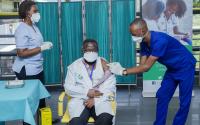[ad_1]
The prevalence of near-sightedness, or myopia, increased 1.4 to 3 times in Chinese children aged 6 to 8 years during COVID-19 quarantine, according to a study today in JAMA Ophthalmology.
Led by researchers at Tianjin Medical University, the prospective study used school-based vision screenings in 123,535 children aged 6 to 13 years from 10 elementary schools in Feicheng, China, over 6 consecutive years, ending in July 2020. They recorded the spherical equivalent refraction for each student and compared their findings, as well as the prevalence of myopia, in children during the pandemic versus in the previous 5 years.
Schools in China were closed from January to May 2020, during which time online learning was offered for 1 hour a day for students in grades 1 and 2 and for 2.5 hours for those in grades 3 to 6.
A substantial shift toward myopia (about -0.3 diopters) was identified in the 194,904 test results (389,808 eyes) from 2020 included in the analysis, compared with those from 2015 to 2019 from children ages 6 (-0.32), 7 (-0.28), and 8 (-0.29). The prevalence of nearsightedness was 3 times higher for children 6 years old, twice as high in those aged 7, and 1.4 times higher for those aged 8.
The prevalence of near-sightedness in 2020 was higher than the highest prevalence in 2015 to 2019 for students ages 6 (21.5% vs 5.7%), 7 (26.2% vs 16.2%), and 8 (37.2% vs 27.7%). Most cases of myopia were mild, and there was little difference in spherical equivalent refraction or prevalence of myopia between 2020 and previous years in children aged 9 to 13 years, even though they were offered online courses for a longer time each day than younger students.
Less time outdoors, more screen time
The authors cautioned that their study was subject to limitations that may preclude accurate interpretation of the links between quarantine and myopia, such as lack of information on adherence to online school offerings, amount of close-up work or screen time, and amount of time spent outside each day.
They concluded, however, that home confinement during the coronavirus pandemic seemed to be linked to a substantial shift toward myopia in students 6 to 8 years old.
Reasons for this, they said, may include less time spent outdoors and more screen time, adding that less outdoor activity is known to be significantly tied to an elevated incidence of myopia in elementary school children.
“Younger children’s refractive status may be more sensitive to environmental changes than older ages, given the younger children are in a critical period for the development of myopia,” the researchers wrote. The topic “requires further evaluation within other populations. If there is such an important period for myopia development, strategies for myopia control and intervention could be implemented with a possibly global influence.”
In an invited commentary in the same journal, Caroline Klaver, MD, PhD; Jan Roelof Polling; and Clair Enthoven, MSc, all of Erasmus University in the Netherlands, speculated that older children’s eyesight may not have changed much because they were already accustomed to spending less time outdoors and more time on screens and doing close-up work before the pandemic began.
“The quarantine measures were and still are important and our best bet to reduce the spread of the virus,” Klaver and colleagues wrote. “Nevertheless, an intelligent lockdown might need to consider careful planning of indoor activities and preferably not restrict outdoor play in young children. That may help control a wave of quarantine myopia.”
[ad_2]
Source link












